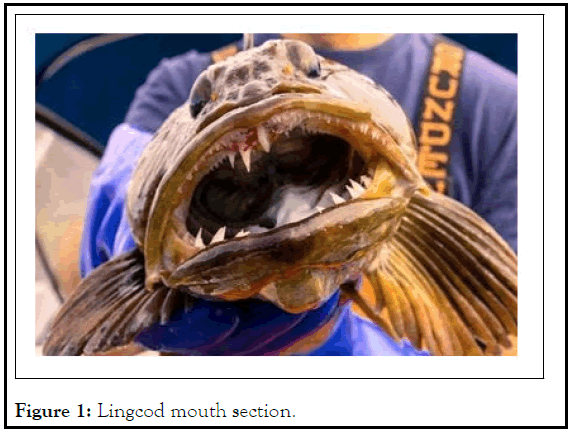Poultry, Fisheries & Wildlife Sciences
Open Access
ISSN: 2375-446X
+44-77-2385-9429
ISSN: 2375-446X
+44-77-2385-9429
Image Article - (2022)Volume 10, Issue 1
The Pacific lingcod which is also called Ophiodon elongatus, can grow up to 1.5 metres in length and 36 kilograms in weight. With a lifespan of over 20 years, it has two sets of jaws with around 500 needle-sharp teeth. A new study titled, "The moment of tooth: rate, fate and pattern of Pacific lingcod dentition revealed by pulse-chase," suggests that the Pacific lingcod can lose up to 20 teeth in a single day and grow them all back out of those 500 teeth.
Pacific lingcod; Tooth
As per the reports of Live Science, Karly Cohen, a doctorate student at the University of Washington and a co-author of the study, stated that every bony surface in their mouths is covered in teeth. The omnivorous creature has hundreds of sharp, nearmicroscopic teeth on its jaws instead of incisors, molars, and canines. Hundreds of microscopic dental stalactites cover their hard palate, as well. Behind one set of jaws, the fish have a second set of accessory jaws called pharyngeal jaws, which they employ to chew food in the same way as humans do with molars (Figure 1).

Figure 1: Lingcod mouth section.
• Scientists stained the fish's teeth with red dye in a seawater tank
The scientists kept 20 lingcod at the University of Washington's Friday Harbor Laboratories to monitor how many teeth they shed and gained on a regular basis. They stained the fish's teeth with red dye in a seawater tank, and then returned them to their regular tank for 10 days, according to CBC News. They next euthanised the fish and examined their jaws to see how many teeth had red colouring. More than 10,000 teeth were counted by the researchers.
Emily Carr, a University of South Florida student researcher and the study's principal author, was responsible for the majority of the work. Cohen said that Emily spent most of her summer sitting at the microscope counting these teeny-tiny teeth. The researchers said that the fish's back rows of teeth were the most frequently changed. In contrast, the outer rows that are meant to catch prey are the ones that do the majority of the chewing, according to CBC News.
• Teeth are not falling out because of wear and strain
Cohen also said that the teeth are not falling out because of wear and strain, but they have adapted and evolved this pattern of replacement somewhere in their own regulation of replacing teeth, according to CBC. Cohen believes that it has to do with keeping the ability to have sharp teeth that are ready to go and ready to eat.
Citation: Ajay VS (2022) This Fish Loses and Regrows Twenty Teeth Each Day. Poult Fish Wildl Sci. 10:003.
Received: 18-Feb-2022, Manuscript No. PFW-22-14796; Editor assigned: 21-Feb-2022, Pre QC No. PFW-22-14796(PQ); Reviewed: 03-Mar-2022, QC No. PFW-22-14796; Revised: 11-Mar-2022, Manuscript No. PFW-22-14796(R); Published: 18-Mar-2022
Copyright: © 2022 Ajay VS. This is an open-access article distributed under the terms of the Creative Commons Attribution License, which permits unrestricted use, distribution, and reproduction in any medium, provided the original author and source are credited.